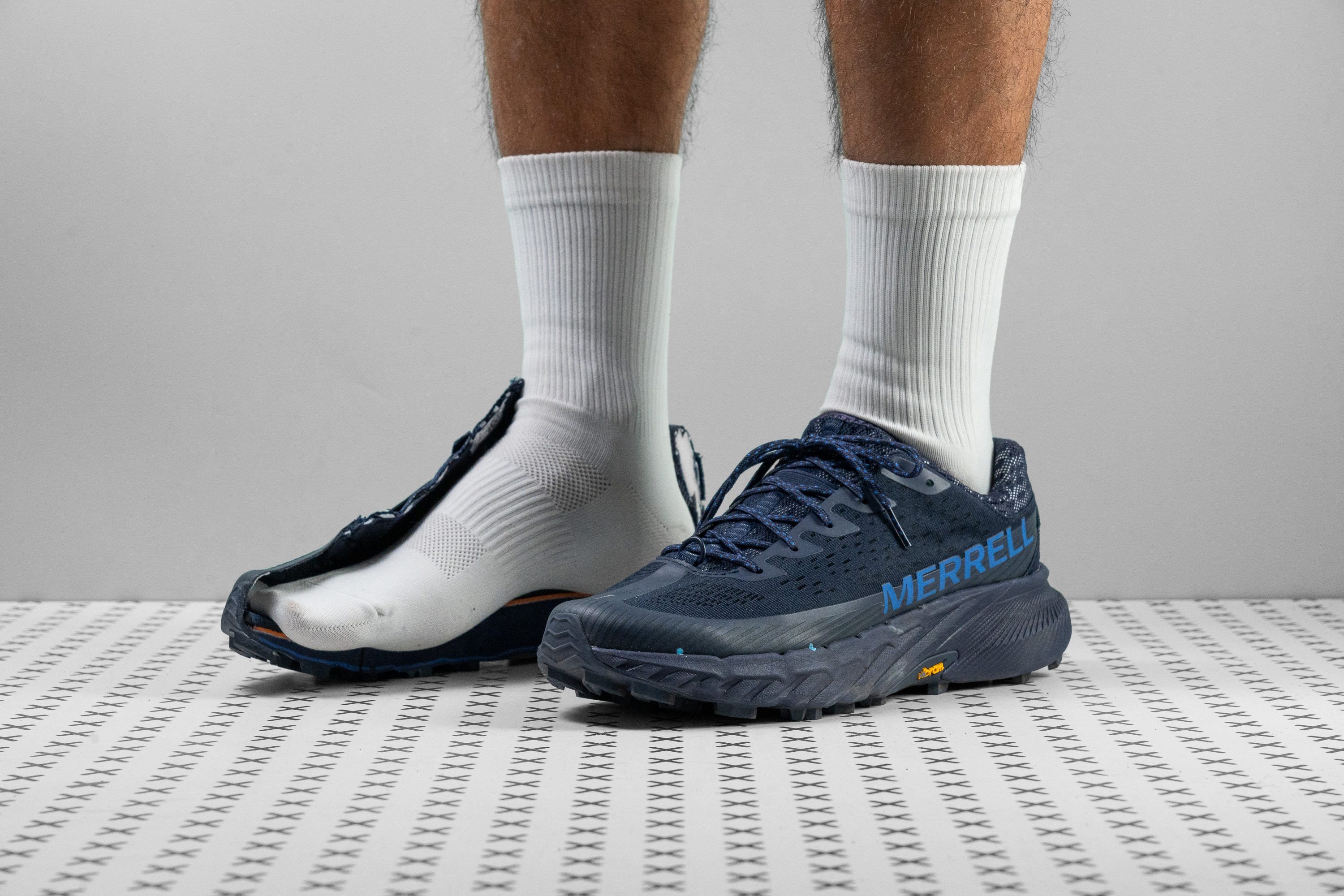Our verdict
- Top pick in best mud running shoes
- Top pick in best Merrell trail running shoes
Pros
- Easily handles tough trails
- Performs well on both downhills and uphills
- Extremely durable upper with numerous TPU reinforcements
- Suitable for year-round use
- Loads of recycled, eco-friendly stuff
- Wonderful for heel strikers
- Excellent all-terrain shoe
Cons
- Grips worse than expected
- Actual drop deviates significantly from what's stated
- Feels flat underfoot
- Narrow toebox
Audience verdict
- Top 23% in Merrell running shoes
- Top 30% in running shoes for hiking
Comparison
The most similar running shoes compared
+ + Add a shoe | |||||
|---|---|---|---|---|---|
| Audience score | 88 Great! | 90 Superb! | 81 Good! | 88 Great! | |
| Price | $140 | $150 | $85 | $185 | |
| Trail terrain | ModerateTechnical | Light | Light | ModerateTechnical | |
| Shock absorption | Moderate | - | Moderate | Moderate | |
| Energy return | Low | - | Low | Moderate | |
| Arch support | Neutral | Neutral | Neutral | Neutral | |
| Weight lab Weight brand | 10.2 oz / 289g 10.6 oz / 300g | 9.7 oz / 275g 10.8 oz / 307g | 10.3 oz / 292g 10.4 oz / 296g | 10.3 oz / 293g 10.4 oz / 295g | |
| Drop lab Drop brand | 13.4 mm 6.0 mm | 11.6 mm 6.0 mm | 10.1 mm 8.0 mm | 7.2 mm 4.0 mm | |
| Strike pattern | Heel | Heel | Heel | Mid/forefoot | |
| Size | True to size | True to size | True to size | True to size | |
| Midsole softness | Balanced | Balanced | Balanced | Soft | |
| Difference in midsole softness in cold | Small | Normal | Normal | Normal | |
| Plate | Rock plate | ✗ | ✗ | ✗ | |
| Toebox durability | Very good | Good | Very bad | Good | |
| Heel padding durability | Decent | Good | Bad | Good | |
| Outsole durability | Good | Good | Decent | Good | |
| Breathability | Moderate | Warm | Moderate | Moderate | |
| Width / fit | Medium | Medium | Medium | Medium | |
| Toebox width | Narrow | Medium | Medium | Narrow | |
| Stiffness | Moderate | Moderate | Flexible | Moderate | |
| Torsional rigidity | Stiff | Stiff | Stiff | Stiff | |
| Heel counter stiffness | Stiff | Stiff | Stiff | Flexible | |
| Lug depth | 4.5 mm | 3.3 mm | 4.0 mm | 3.9 mm | |
| Heel stack lab Heel stack brand | 39.2 mm 39.0 mm | 35.8 mm 30.0 mm | 37.7 mm 36.0 mm | 38.0 mm 33.0 mm | |
| Forefoot lab Forefoot brand | 25.8 mm 33.0 mm | 24.2 mm 24.0 mm | 27.6 mm 28.0 mm | 30.8 mm 29.0 mm | |
| Widths available | Normal | Normal | Normal | Normal | |
| For heavy runners | ✓ | ✗ | ✓ | ✗ | |
| Season | All seasons | All seasons | All seasons | All seasons | |
| Removable insole | ✓ | ✓ | ✓ | ✓ | |
| Orthotic friendly | ✓ | ✓ | ✓ | ✓ | |
| Ranking | #143 Top 39% | #48 Top 13% | #305 Bottom 18% | #134 Top 36% | |
| Popularity | #121 Top 33% | #223 Bottom 40% | #205 Bottom 45% | #103 Top 28% |
Who should buy
We believe the Merrell Agility Peak 5 is a solid pick for:
- Heel strikers looking for a stable, all-terrain trail running shoe.
- Runners in need of a shoe that excels in muddy or snowy conditions.
- Those who desire a trail shoe that offers a great mix of durability, stability, and effective cornering.
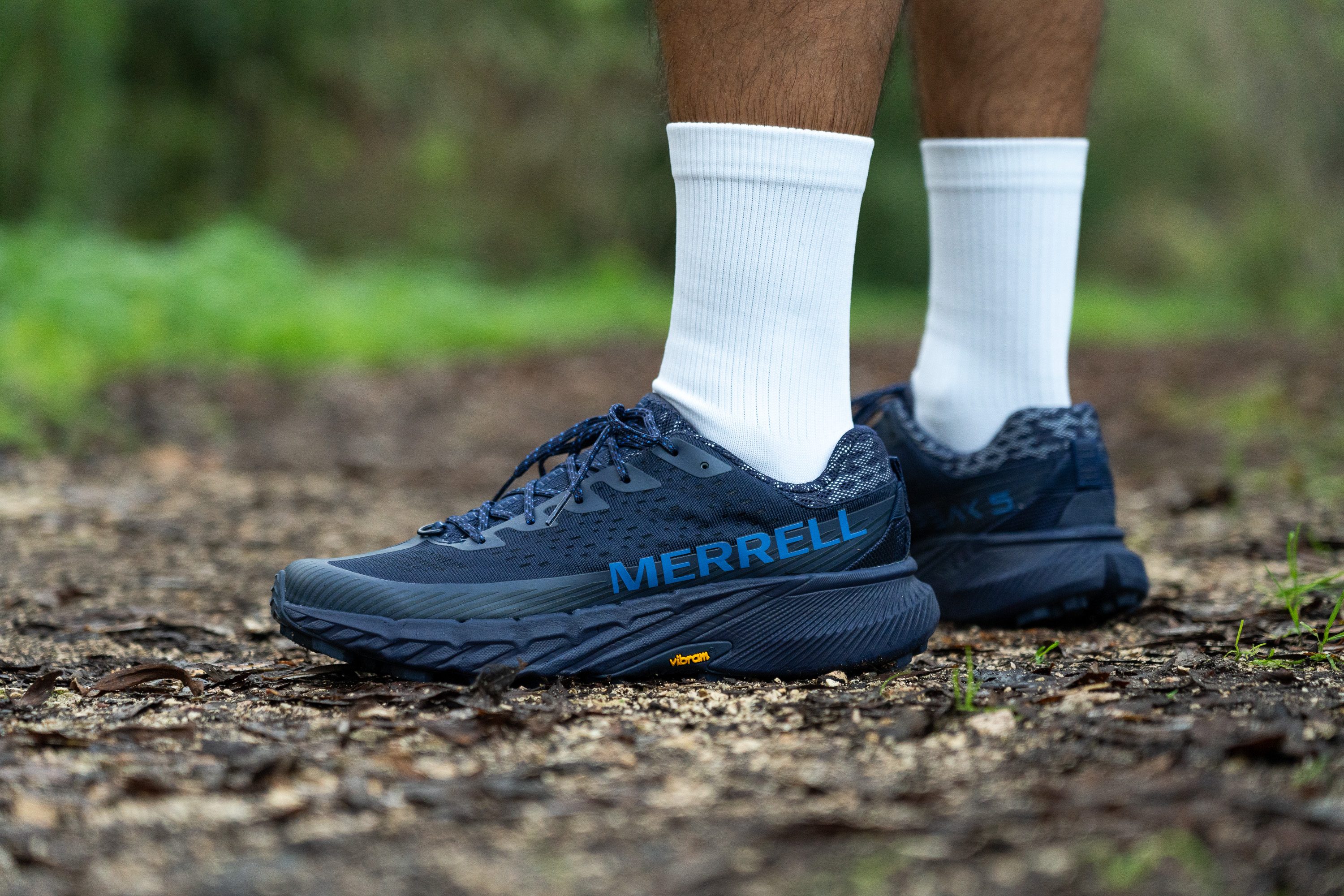
Who should NOT buy
Although the Merrell Agility Peak 5 is highly versatile, in our view it's not the ideal choice for those who primarily run on smooth paths or fire roads. For such terrains, other shoes like the Merrell Nova 3 or the Saucony Peregrine 13 might be better suited.
Additionally, it's not our top pick for forefoot or midfoot strikers due to its significant heel-to-toe drop. If you use one of these running techniques, we recommend opting for the Hoka Speedgoat 5 instead.
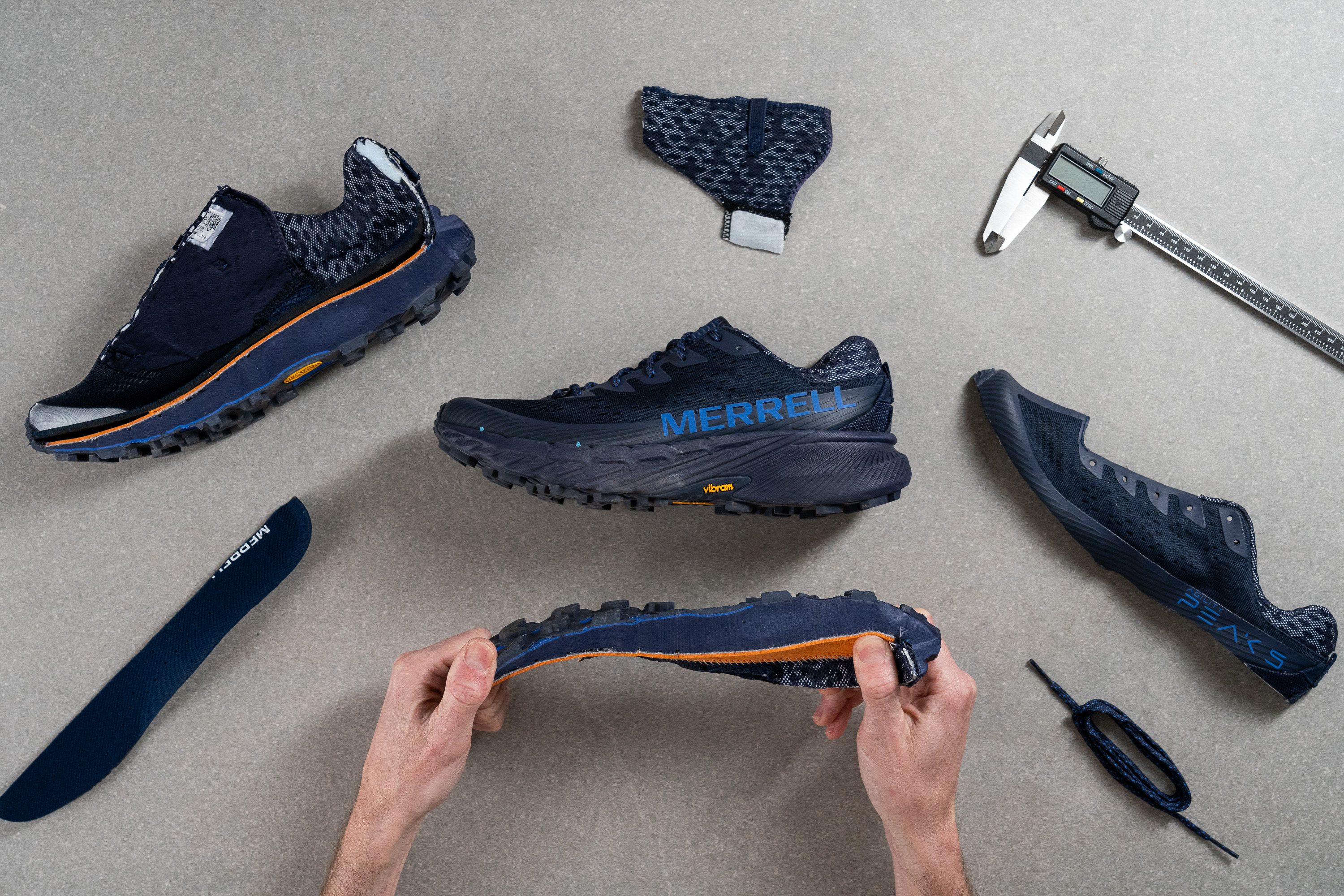
Cushioning
Shock absorption
If there’s one word to define the Merrell Agility Peak 5, it’s versatility. The shock absorption numbers back that up with 125 SA in the heel and 99 SA in the forefoot, both landing close to the lab’s average.
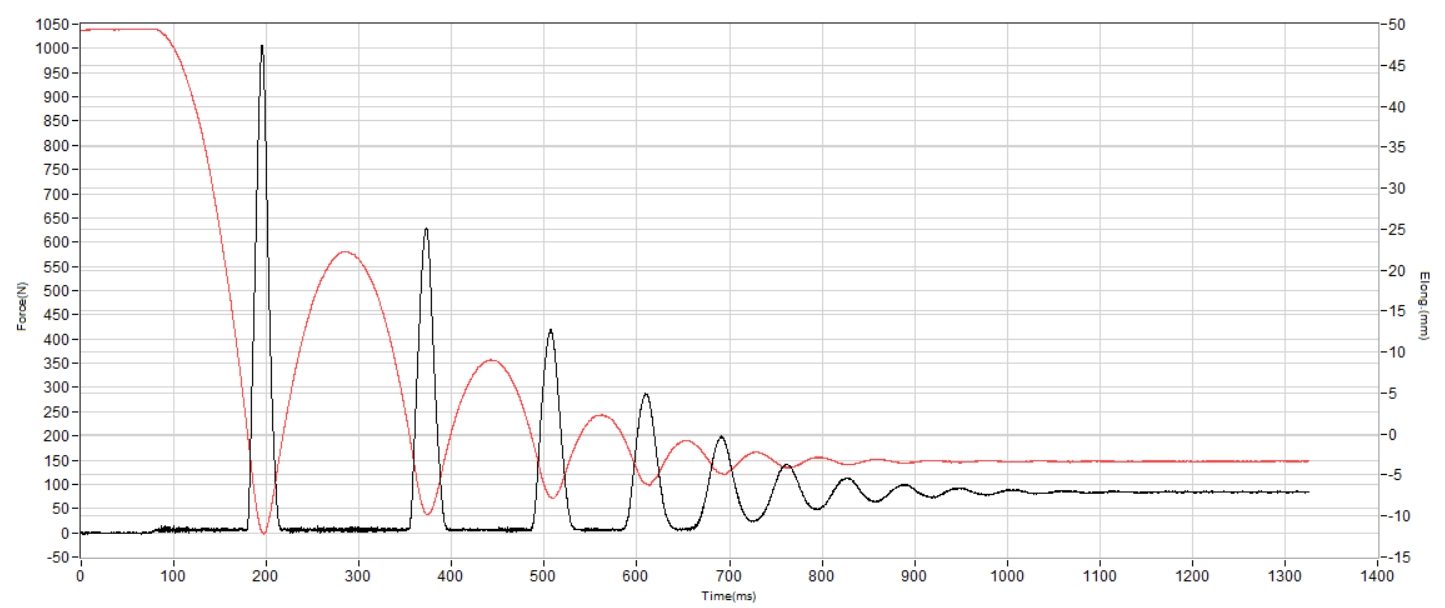
| Agility Peak 5 | 125 SA |
| Average | 122 SA |
Energy return
Our main gripe with the Agility Peak 5 was that, despite its high cushioning, it lacks energy. We clearly felt it during our runs, and the lab test confirmed it: only 48.7% in the heel and 52.0% in the forefoot.
| Agility Peak 5 | 48.7% |
| Average | 55.6% |
Heel stack
In the heel, we measured a generous amount of foam, with the stack height reaching an impressive 39.2 mm.
This instantly makes the shoe a fantastic choice for every heel striker, ensuring ample protection against sharp rocks. This is particularly beneficial because the shoe includes a rock plate, but only in the midfoot and forefoot areas.

| Agility Peak 5 | 39.2 mm |
| Average | 32.6 mm |
Forefoot stack
Shifting to the forefoot, we found it thinner than expected, at just 25.8 mm. However, it's still thicker than the average shoe.
We believe that the Agility Peak 5 is well-suited for ultra races and long endurance sessions, even for midfoot and forefoot strikers.
Also, there's a blue rock plate underneath the foam to protect the feet in this thinner area.
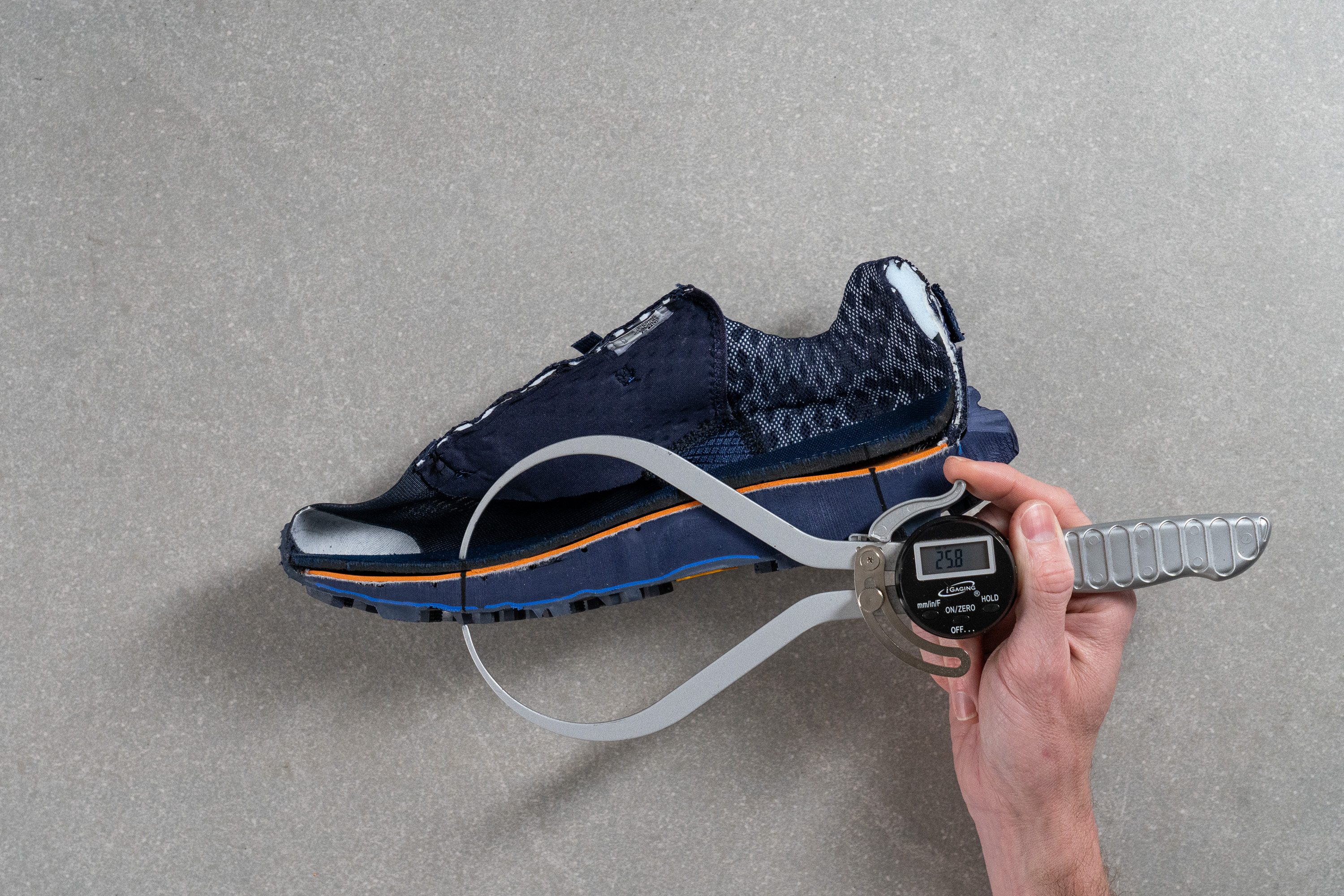
| Agility Peak 5 | 25.8 mm |
| Average | 25.1 mm |
Drop
Our tests showed a huge 13.4-mm offset, which is a major difference from the 6-mm drop Merrell advertises. Why?
Well, we strictly adhere to World Athletics guidelines for measuring every shoe. It's likely that Merrell takes their measurements at undisclosed spots, leading to the differences we observe.

| Agility Peak 5 | 13.4 mm |
| Average | 7.5 mm |
Midsole softness
Talking about cushioning, let's look at the midsole. The Merrell Agility Peak 5 uses FloatPro foam. This is an improved EVA-based material that provides a balanced ride.
Our durometer test confirmed this, showing a 22.0 HA rating. It's neither too soft nor too firm, which in our opinion, is great for trail running.
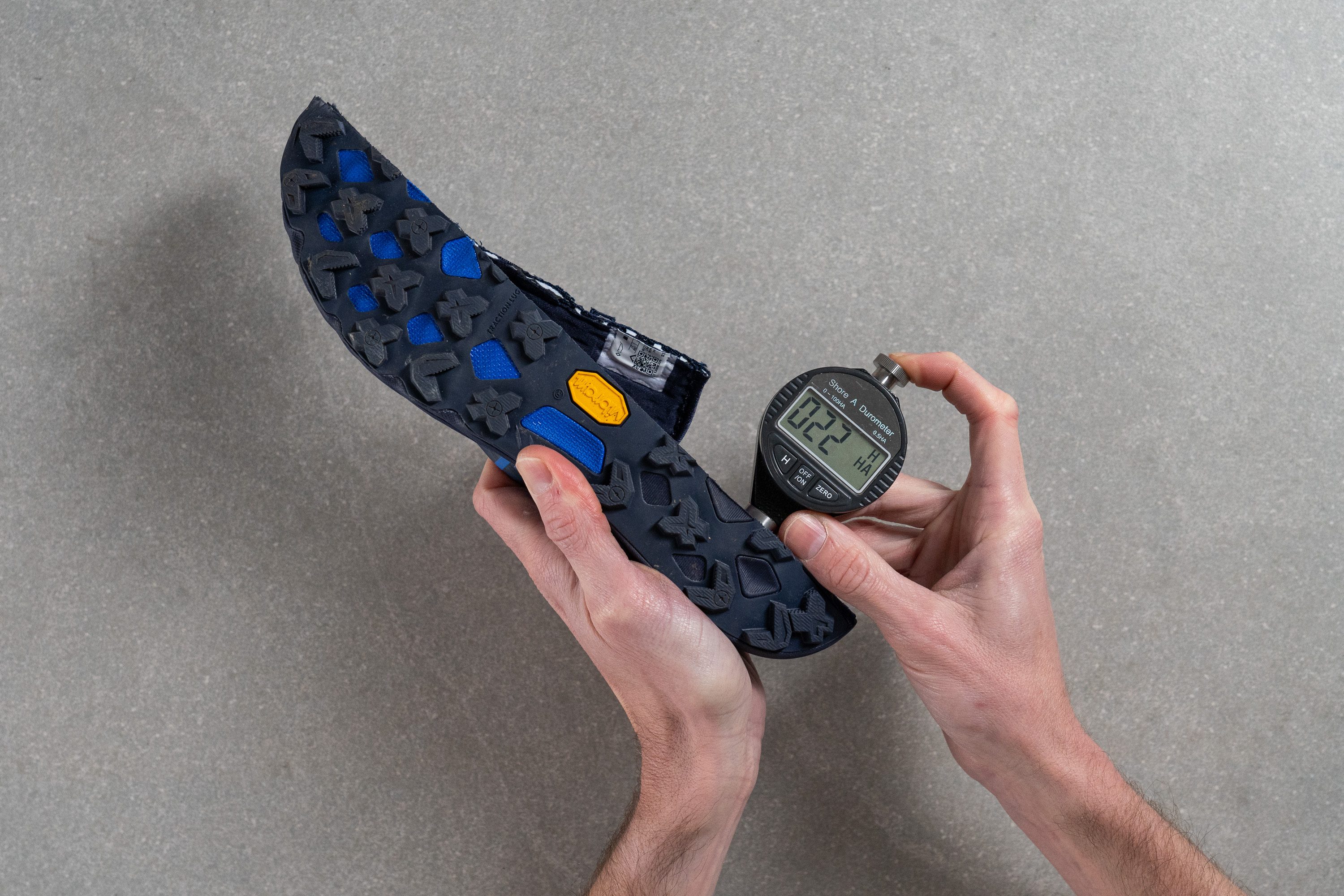
| Agility Peak 5 | 22.0 HA |
| Average | 21.9 HA |
Size and fit
Size
Merrell Agility Peak 5 fits true to size (51 votes).
Width / Fit
The toebox of the Merrell Agility Peak 5 is clearly designed for those who enjoy a snug fit. This helps when taking corners and provides a confident feel on the most technical terrain.
However, those with wide feet should be aware that this shoe doesn't offer much room inside. In our lab, the widest part measured only 93.7 mm.
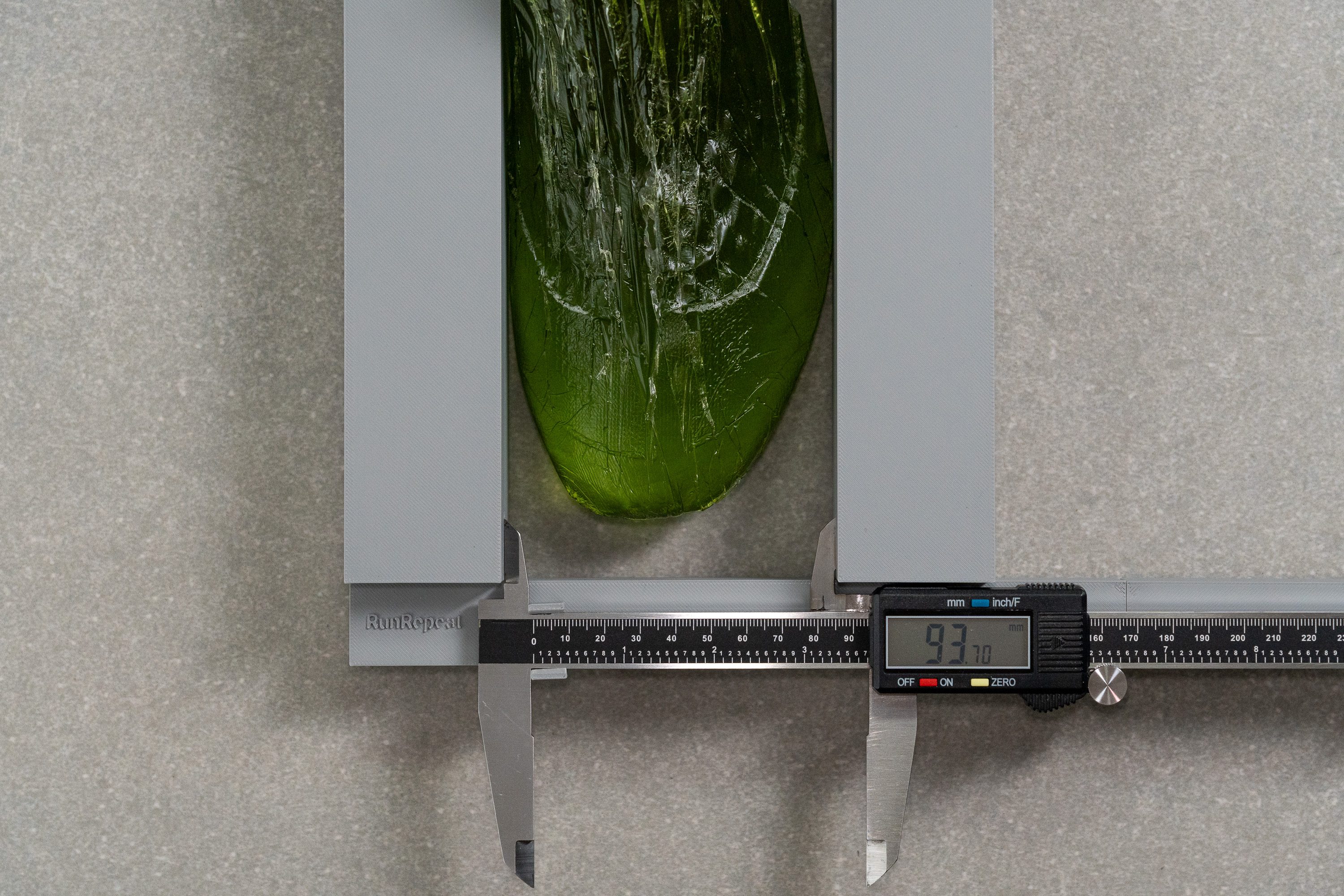
| Agility Peak 5 | 93.7 mm |
| Average | 95.6 mm |
Toebox width
The toe area of the shoe receives the same treatment. At 70.4 mm, it tapers significantly and doesn't leave much room for toe splay. We think that this is a shoe only suited for those with narrow feet.

| Agility Peak 5 | 70.4 mm |
| Average | 74.6 mm |
Toebox height
We found the toe area offers decent vertical space for upward movement, measuring 27.0 mm—a surprising result considering the narrower dimensions recorded in the other two measurements.

| Agility Peak 5 | 27.0 mm |
| Average | 27.1 mm |
Traction / Grip
Lug depth
The outsole is arguably the most important part of any trail shoe. Analyzing the Agility Peak 5, we discovered an outsole tailored for technical terrain, featuring 4.5-mm Traction Lugs lugs spaced widely apart.
This design allows for efficient mud or snow clearing and solid traction. The lugs vary in shape, with some chevron-shaped and others butterfly-shaped. There are fewer lugs than before, also enhancing the space between them. The v5 has only 31 lugs, a significant drop from the 52 of its predecessor.
| Agility Peak 5 | 4.5 mm |
| Average | 3.5 mm |
Outsole design
Chevron-shaped lugs are widely spaced across the outsole, featuring a multi-directional layout designed to adapt to uneven terrain. This configuration appears better suited for wet and muddy trails, where larger gaps help with debris shedding—but it also impacted the grip score in our lab test.

Flexibility / Stiffness
Earlier, we noticed that the shoe was very rigid when we tried twisting it. Now, it's time for our second flexibility test. Here, we're looking to see how flexible it is longitudinally.
Indeed, we found it a bit stiffer than average, confirming our previous observations. We had to apply 16.8N of force to bend the shoe to a 30-degree angle.
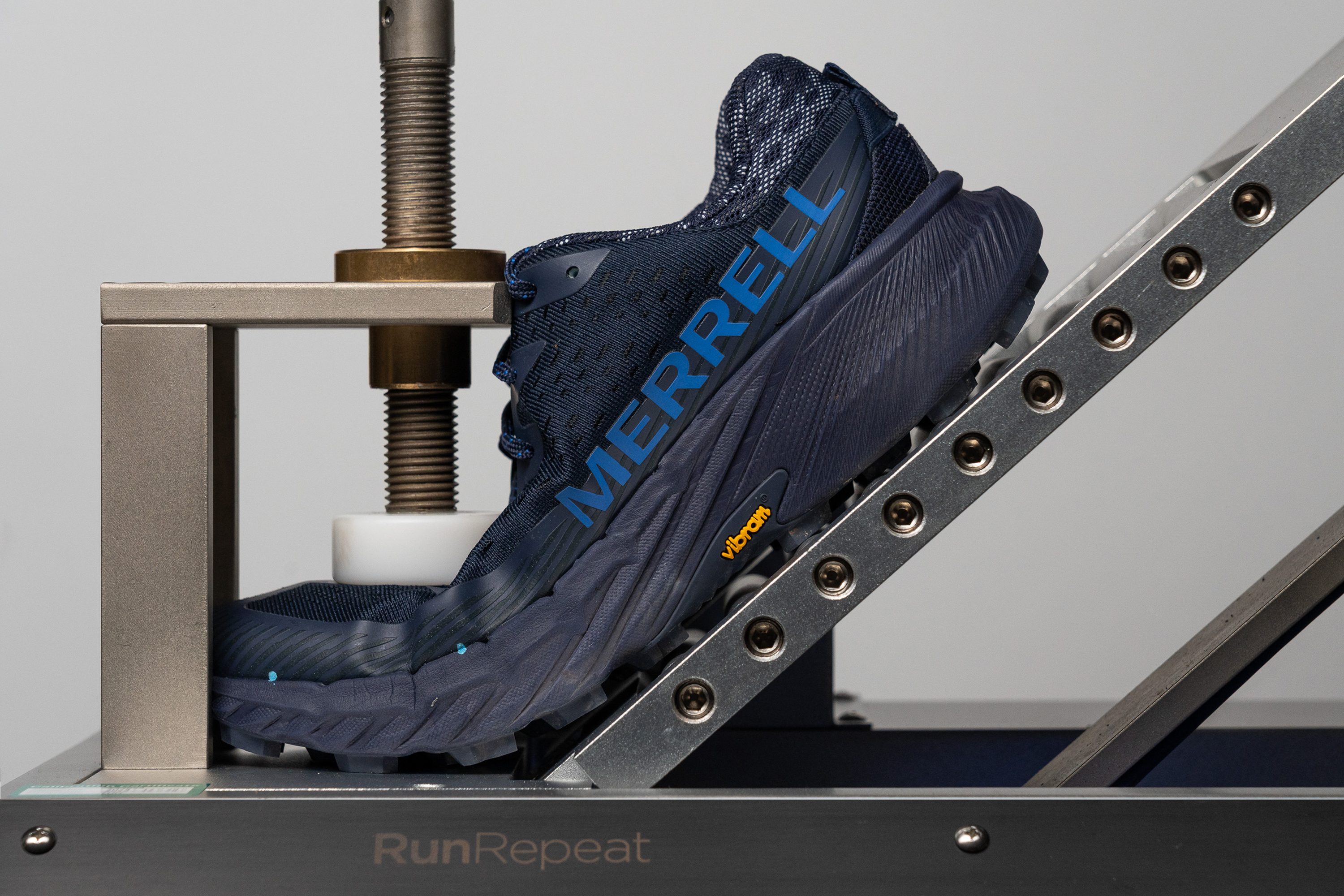
| Agility Peak 5 | 16.8N |
| Average | 14.7N |
Stiffness in cold
We conducted the 20-minute freezing test again to assess the shoe's stiffness in cold winter conditions. Following the test, it required 45.5N of force from our arm to bend the shoe.
| Agility Peak 5 | 45.5N |
| Average | 35.9N |
Weight
This Merrell slightly exceeds the 10-oz benchmark at 10.2 oz (289g).
While the shoe doesn't feel extremely heavy, it could definitely benefit from shedding 0.5 to 1 oz. With today's technology, this reduction should be achievable.
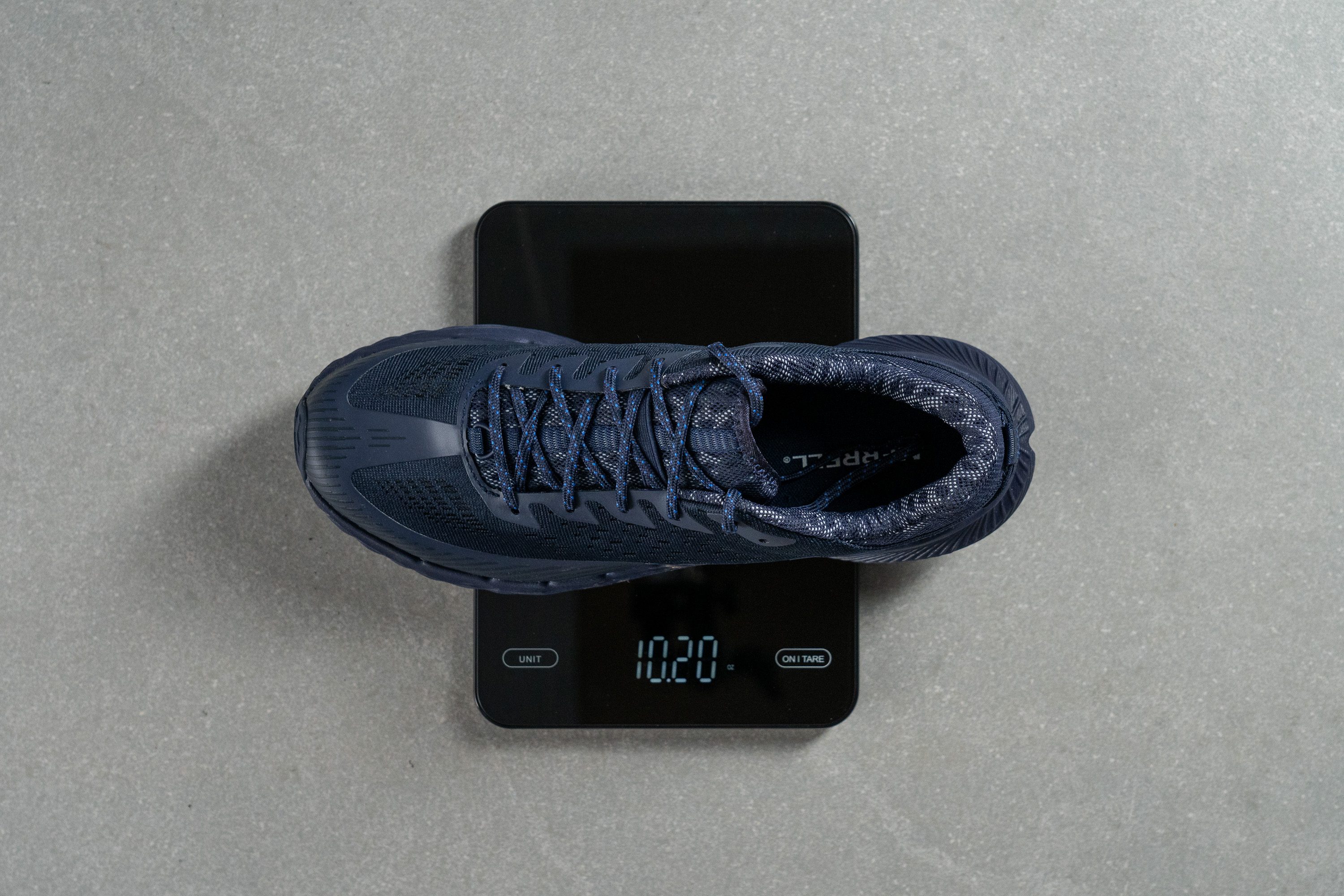
| Agility Peak 5 | 10.2 oz (289g) |
| Average | 10.2 oz (289g) |
Breathability
As we mentioned before, this shoe is designed for technical terrain and wild adventures, so it needs a rugged and durable upper. Typically, this reduces airflow, but Merrell managed to achieve a decent balance, so we gave the shoe a 3/5 rating for airflow after our smoke test.
A 3/5 rating might seem worse than 5/5, but that's not necessarily true here. It all depends on what we're looking for.
In a trail shoe like this one, we wanted a balance that keeps it comfortable in winter while still being somewhat airy in summer. It won't be perfect in extreme temperatures, but it does a decent job across the whole spectrum.
A simple light test really showed us the truth about the airflow. Merrell focused on the toebox for ventilation, but made the midfoot really structured for better stability, so we shouldn't expect much airflow there.
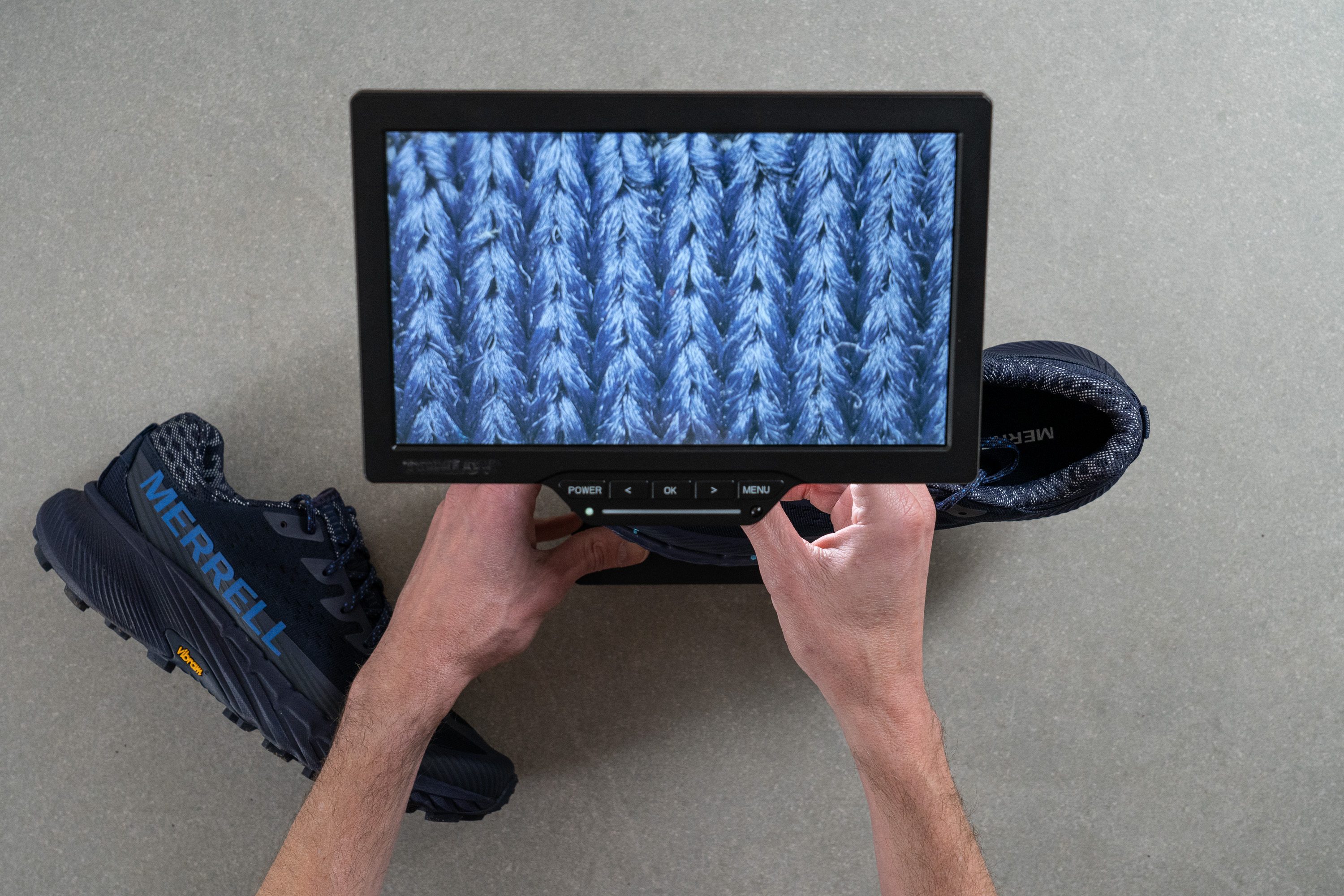
Next, we used our microscope and found a dense engineered mesh that looks very durable. We'll discuss this more after our next test, which will really challenge the upper.
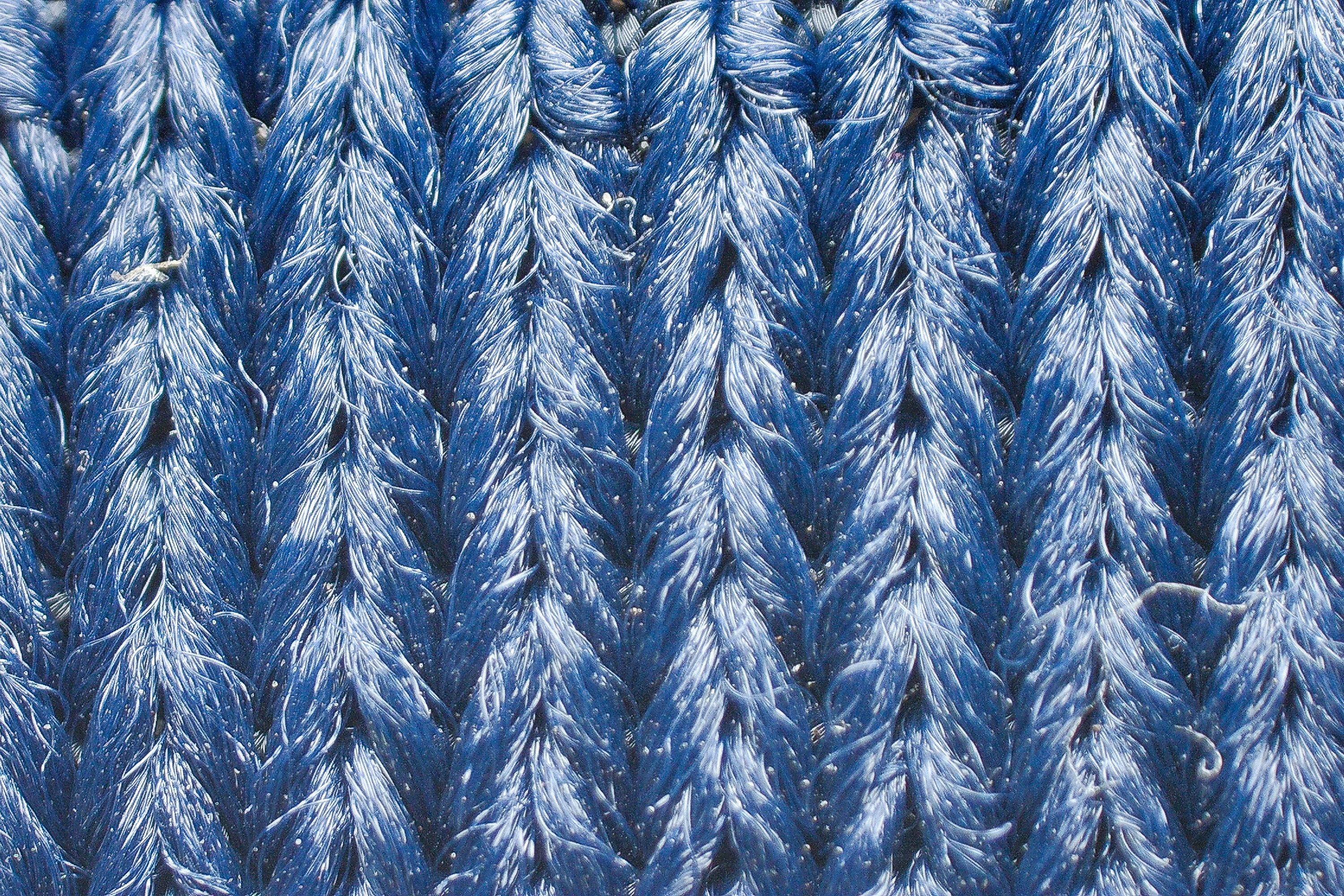
Finally, we thoroughly examined the cut upper.
We noticed that Merrell skipped any inner layer in the toebox for extra protection, which significantly improved airflow.
| Agility Peak 5 | 3 |
| Average | 3.2 |
Stability
Lateral stability test
Regarding stability, this Merrell performs well for a 40-mm shoe. Naturally, you can't expect it to be as hyper-stable as a lower-profile shoe, but we felt truly confident with it.
However, the Agility Peak series isn't designed for those seeking top-level stability. The name "Agility" suggests the shoe is meant to be agile, perfect for sharp turns. This implies that the shoe won't be extremely wide, but rather the opposite.
Torsional rigidity
Even with the outsole cutouts designed to make it less rigid, we still gave the Agility Peak a 5/5 rating in our torsional rigidity test. This rigidity tries to compensate the lack of width of the shoe, although a bit more flexibility would be beneficial for cornering.
| Agility Peak 5 | 5 |
| Average | 3.6 |
Heel counter stiffness
The heel counter is also stiff, and we rated it 4/5.
We believe this approach is spot on, as it keeps the heel secure and enhances the ride for heel strikers. In our opinion, those who strike with their heel are the ideal type of runner for the Agility Peak 5, especially because of the massive heel-to-toe drop.
| Agility Peak 5 | 4 |
| Average | 3 |
Midsole width - forefoot
As we mentioned earlier in this review, since the shoe is designed for "agility," it doesn't follow the currently popular maximalist, wide approach.
Instead, it takes the opposite direction, aiming for a nimble experience. This results in an average forefoot platform width of 111.8 mm.
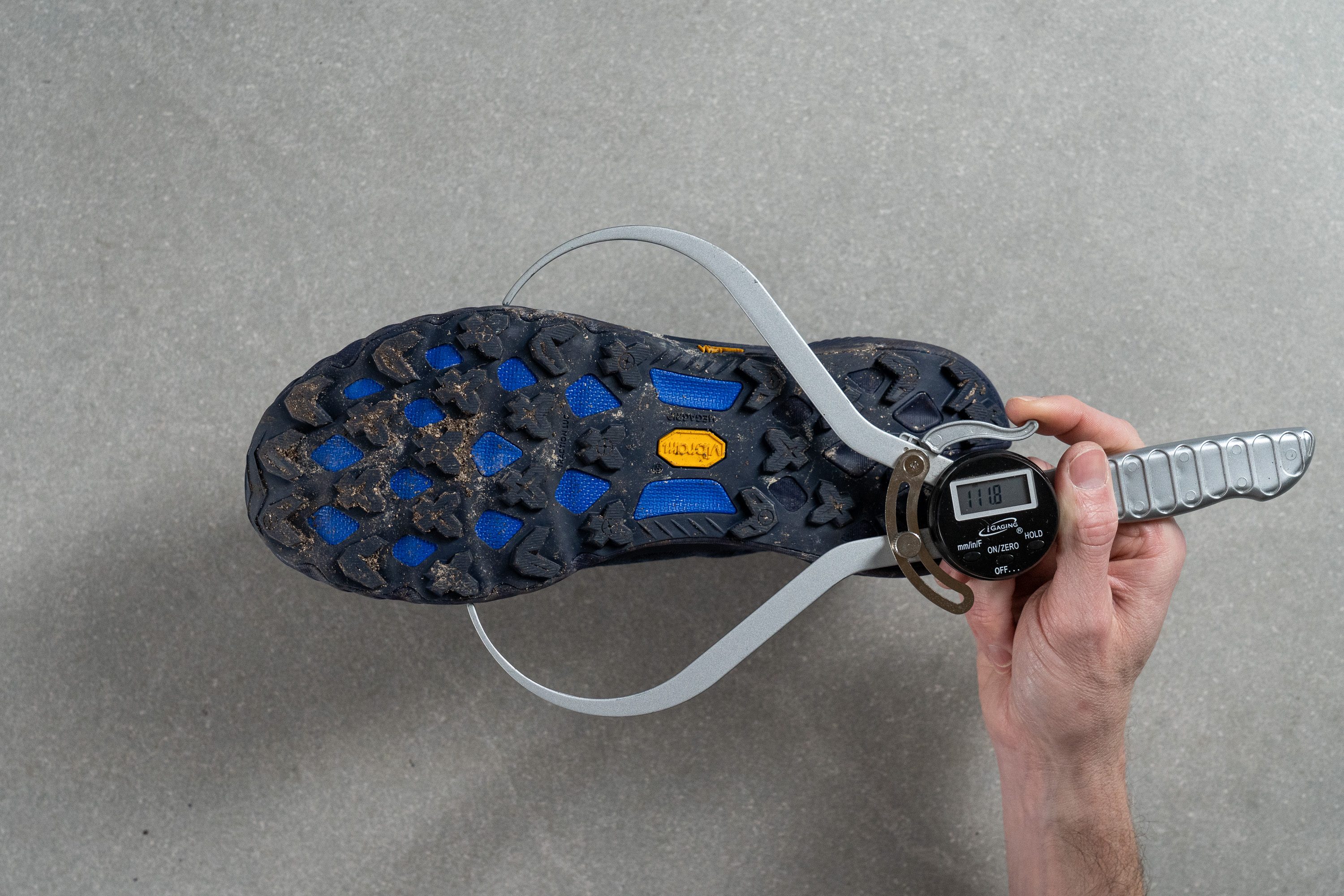
| Agility Peak 5 | 111.8 mm |
| Average | 112.8 mm |
Midsole width - heel
The heel is a bit wider compared to the average trail shoe at 93.0 mm, which makes sense.
Again, as we said before, this shoe is mostly designed for heel strikers. This design ensures stability in the rearfoot and also helps during descents.

| Agility Peak 5 | 93.0 mm |
| Average | 89.9 mm |
Durability
Toebox durability
Like we mentioned earlier, the toebox has a single layer of breathable mesh, so we were curious about how it would do in our Dremel test.
Luckily, Merrell added protective layers to crucial areas of the shoe, and it turns out our test spot was one of them. So, it scored a perfect 5/5 in our test.
Of course, the results might have been different in another part of the toebox, but we test the exact same spot on every shoe, using the same force and RPM, to keep our tests consistent and fair.

| Agility Peak 5 | 5 |
| Average | 3.1 |
Heel padding durability
The heel padding area felt really cozy when we checked it out, and often, that's not a good sign regarding durability.
As expected, it scored a mere 2/5 in our Dremel test, which is disappointing. Although this might not be an issue for most people over time, it's still a drawback worth noting.
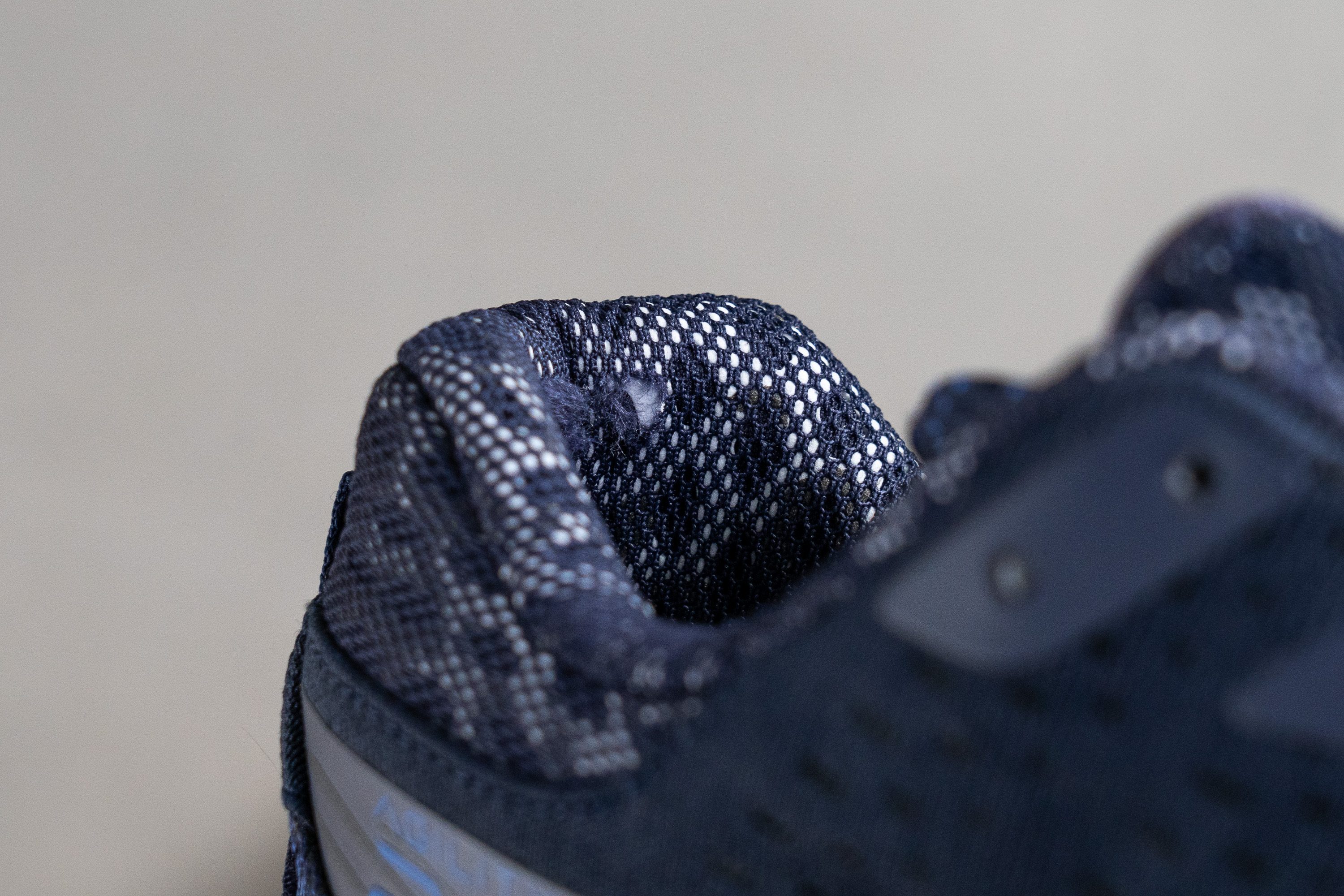
| Agility Peak 5 | 2 |
| Average | 3 |
Outsole hardness
We flipped the shoe over to examine the outsole, a crucial component of any trail running shoe. We discovered what we think is the best rubber for trail running as of today: Vibram Megagrip.
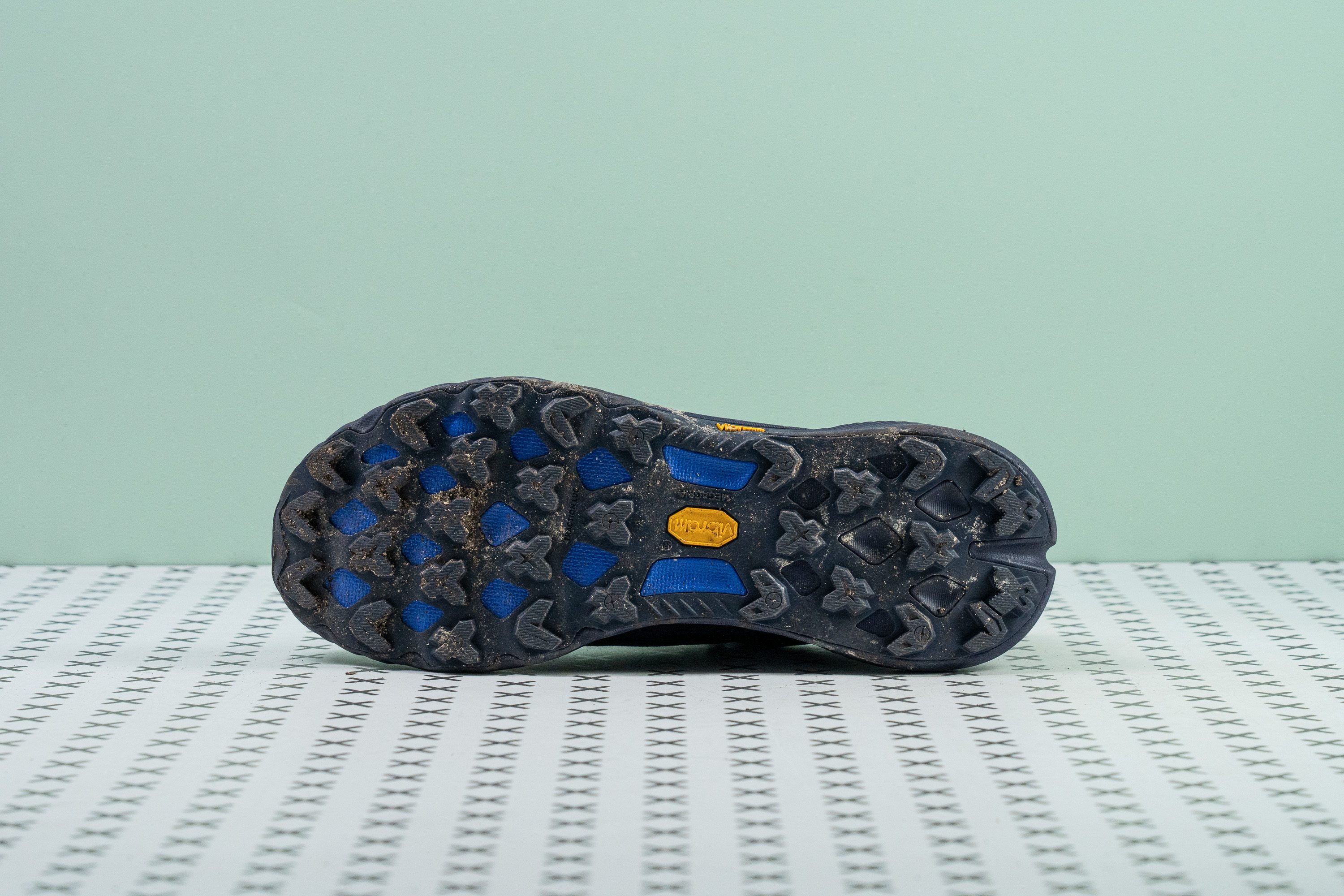
First, in terms of durability, we measured the hardness and found it to be 85.1 HC, which is pretty standard.

| Agility Peak 5 | 85.1 HC |
| Average | 85.8 HC |
Outsole durability
We tested the shoe in the trails and were impressed by its outstanding grip. However, we also look for durability, especially when running over tough terrain that crush the rubber. That's why we fired up the Dremel one last time!
After the Dremel worked its magic, we measured a 0.7-mm indentation in the upper. This is a fantastic result, promising a solid lifespan for the shoe.
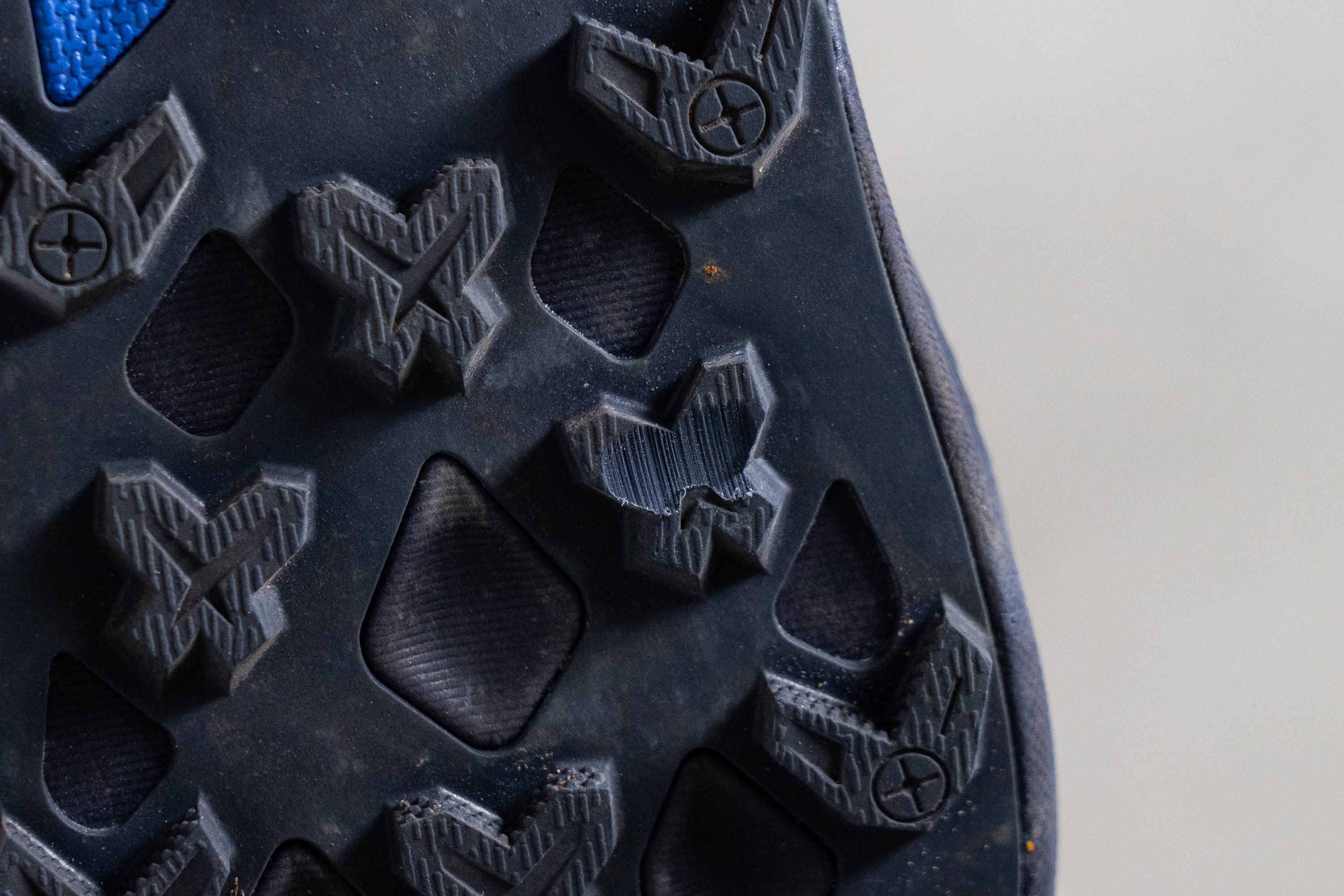
| Agility Peak 5 | 0.7 mm |
| Average | 0.9 mm |
Outsole thickness
The outsole is thinner than what we usually see in trail running shoes, at only 1.4 mm, but there are two reasons for this. First, the lugs are long, which we'll discuss more later in this review. Second, Merrell was already pushing the weight limit. With the long-lasting Vibram Megagrip, why add more rubber than needed?
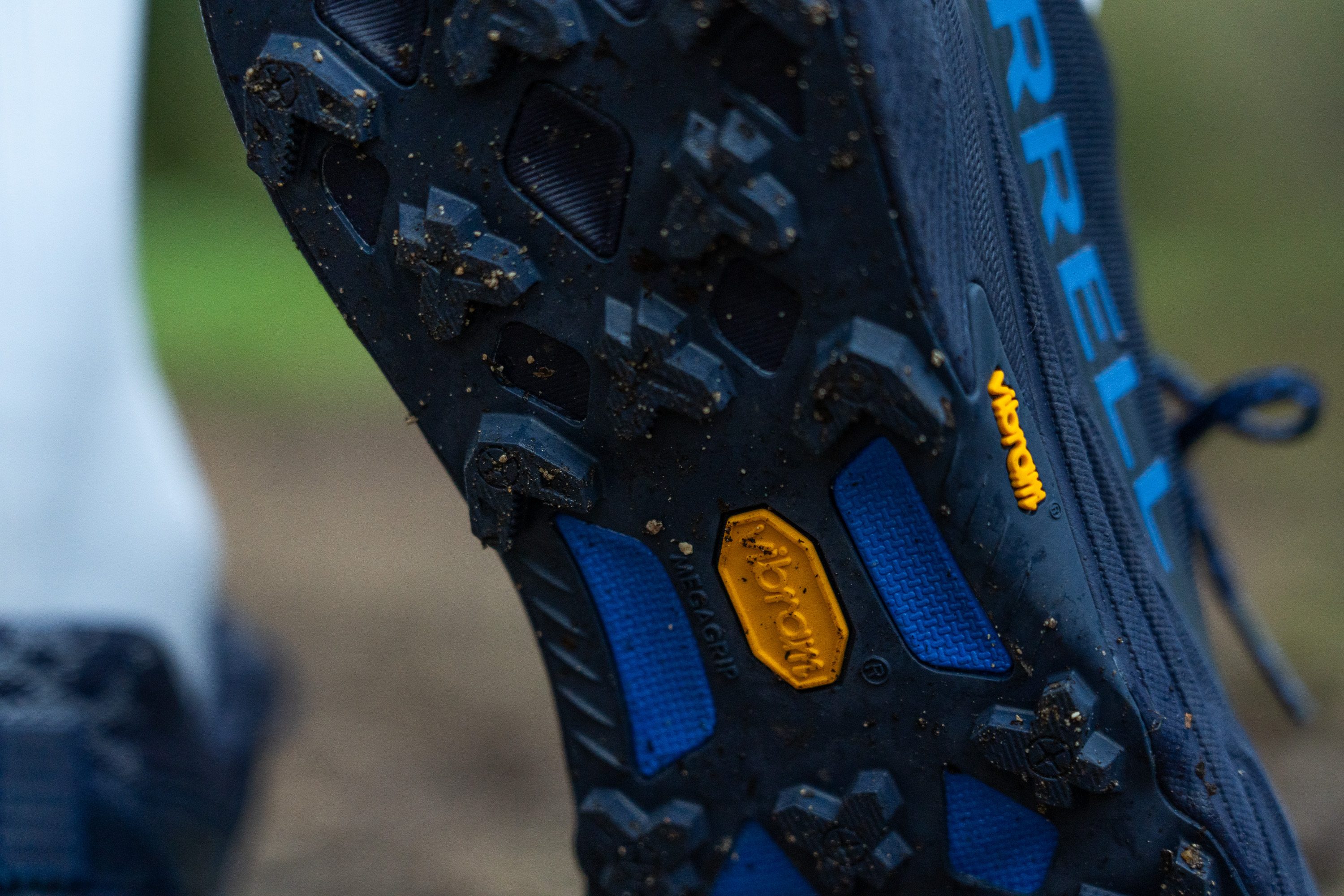
Plus, having a thin outsole means the ride feels less muted. This is often a problem in trail shoes, so it's a nice bonus.
| Agility Peak 5 | 1.4 mm |
| Average | 2.2 mm |
Misc
Insole thickness
The insole is a bit thicker than the average, measuring 6.0 mm in our lab. This contributes to the overall cushioned feel of the shoe.
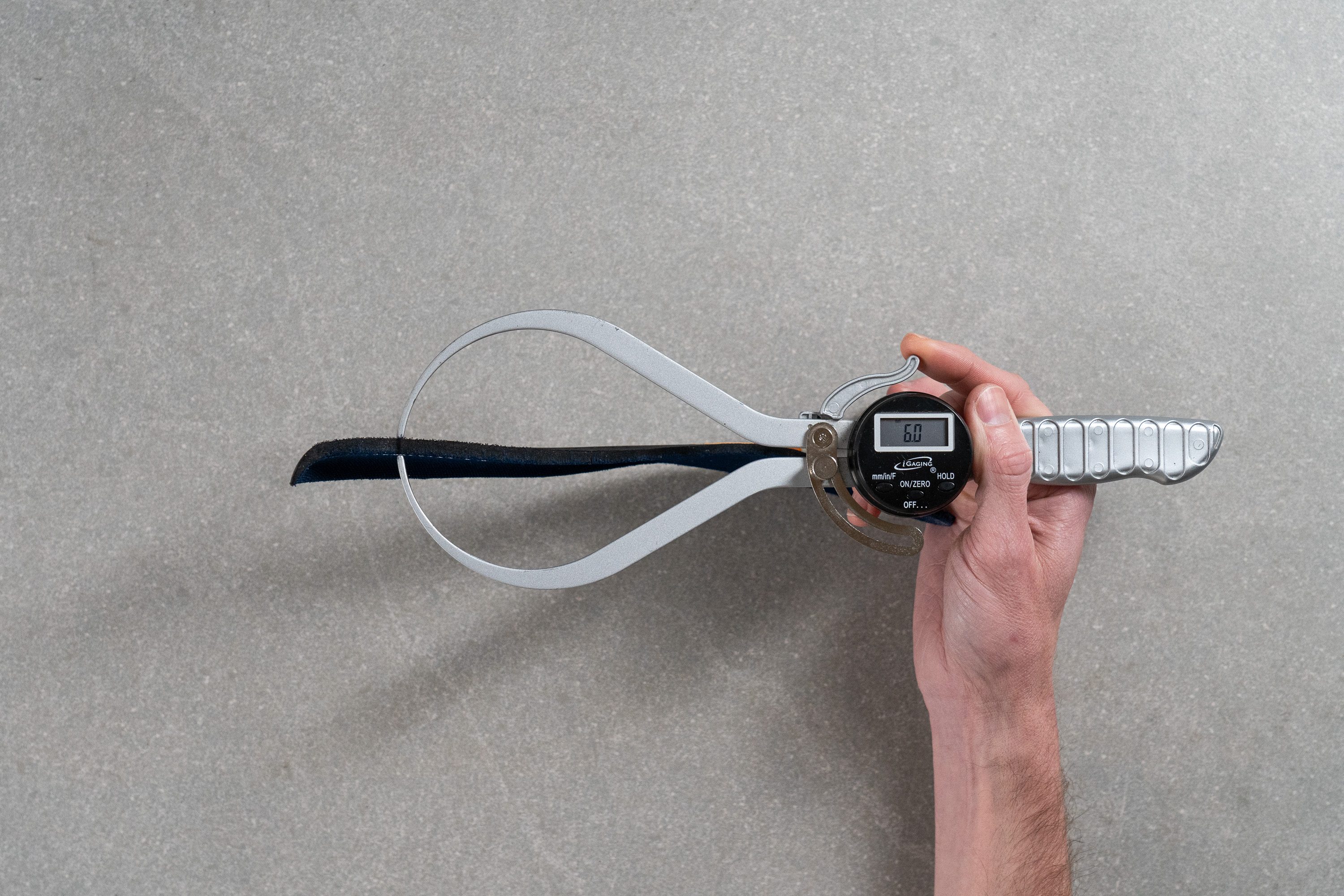
| Agility Peak 5 | 6.0 mm |
| Average | 4.7 mm |
Removable insole
The insole is completely removable since it's not glued to the midsole.
This is great, but it means if we swap out the insole, we'll lose a unique feature of this Merrell shoe—the Cleansport NXT treatment that controls odor in the standard insole.

| Agility Peak 5 | Yes |
Midsole softness in cold
We can imagine many adventurers taking the Agility Peak 5 into very cold mountain temperatures, so this test is quite interesting. We freeze the shoe for 20 minutes and then re-test it to see how much it changes.
We discovered that the shoe barely changed, now measuring 24.6 HA.
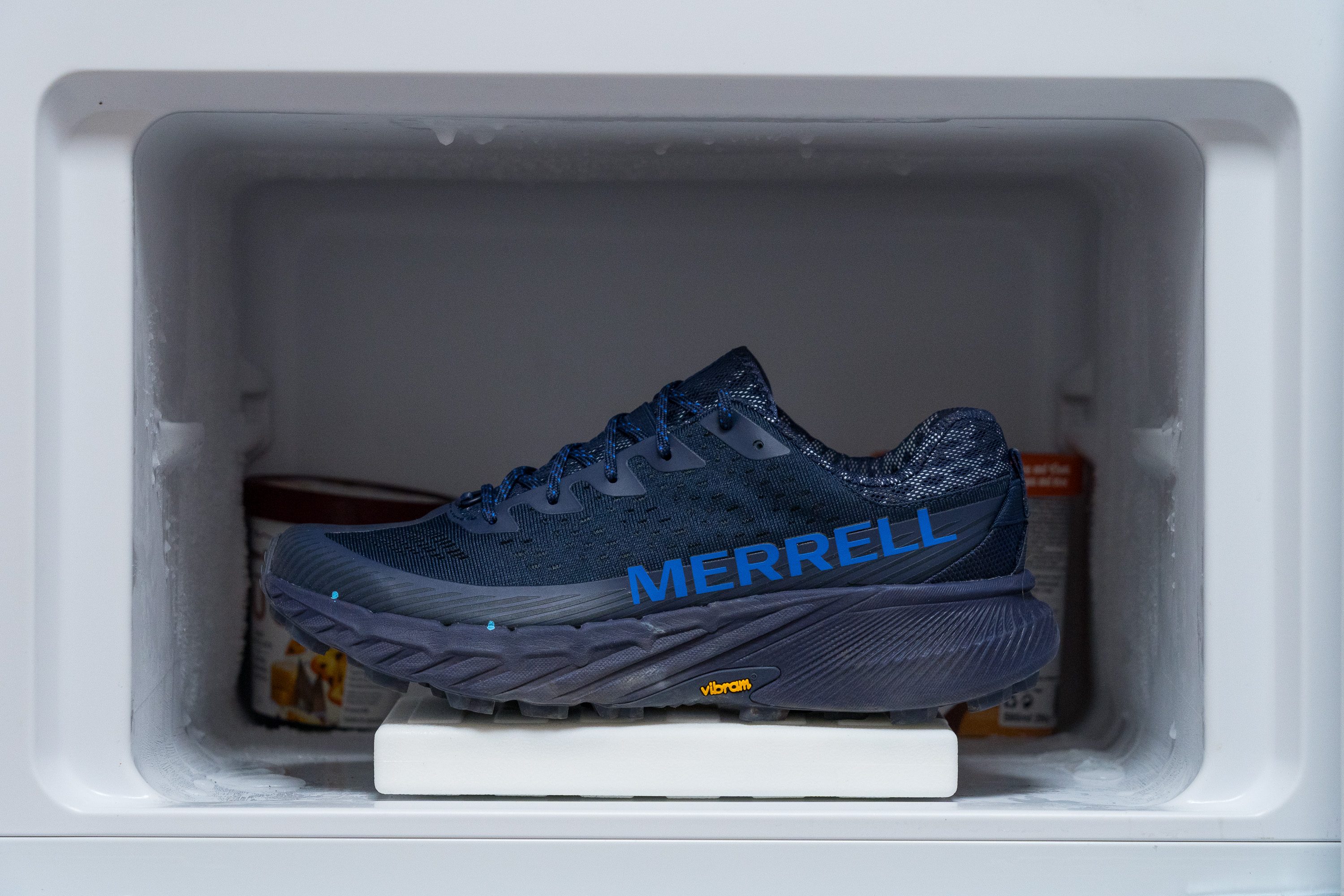
| Agility Peak 5 | 24.6 HA |
| Average | 27.4 HA |
Midsole softness in cold (%)
That's just a 12% change, which is practically imperceptible and an amazing result for an EVA foam. These foams typically underperform in cold temperatures.
| Agility Peak 5 | 12% |
| Average | 26% |
Reflective elements
One of the shoe's disappointments is its missing reflective elements.
You'd think a shoe designed for all-year, all-terrain use would include this, especially for night runs. It's important to be visible when a headlamp shines on you, but the Agility Peak 5 doesn't help with that.

| Agility Peak 5 | No |
Tongue padding
The tongue is often one of the last parts designed in a shoe because it's easy to change and modify to fit the shoe's overall characteristics.
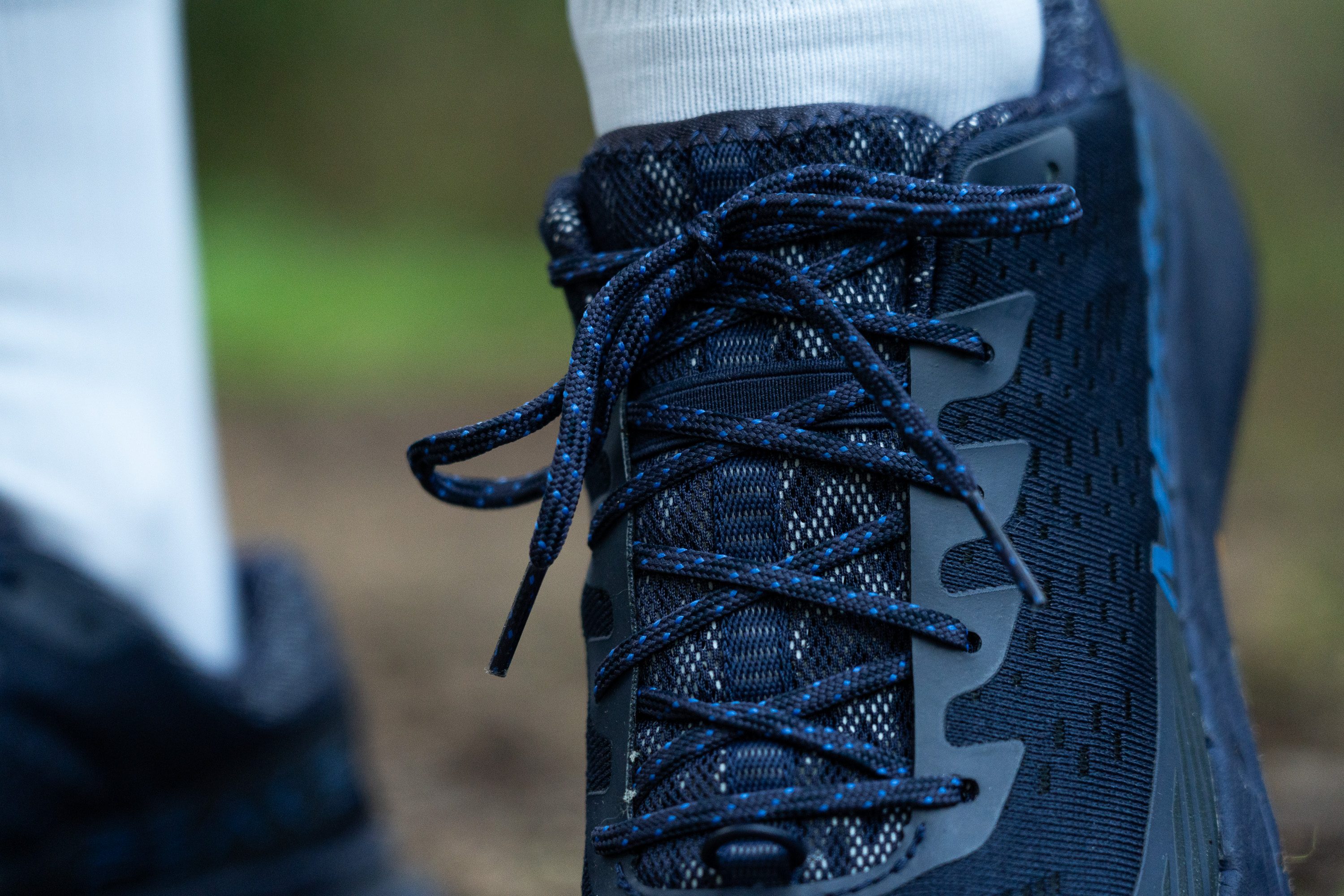
This is a perfect example of that. We're confident that the original design for this tongue was thicker. However, when Merrell weighed the shoe, we're sure that for them it turned out to be too heavy. So, one of the simplest ways to cut down weight in a trail running shoe is to use a thinner, less padded tongue (3.3 mm).
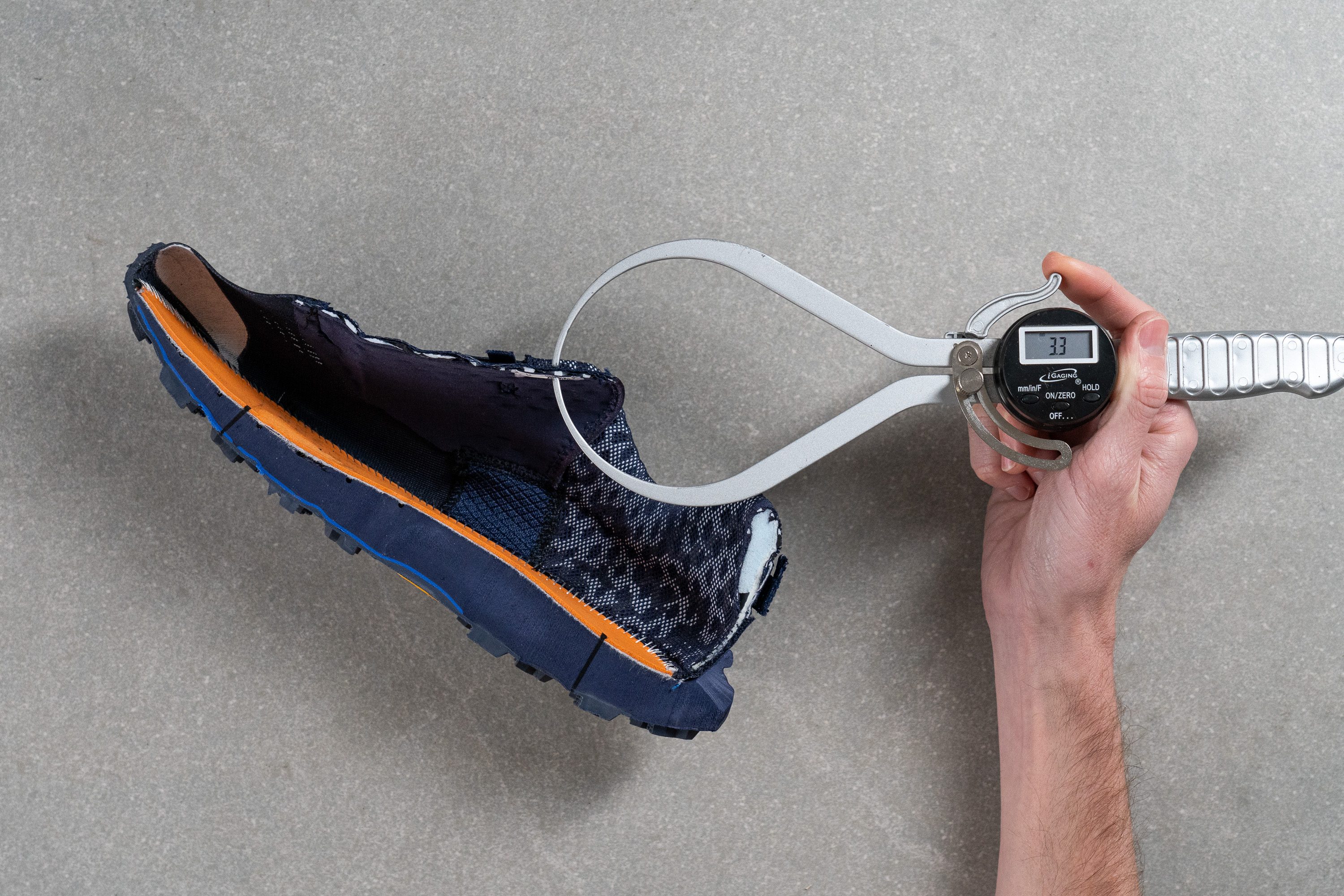
| Agility Peak 5 | 3.3 mm |
| Average | 6.4 mm |
Tongue: gusset type
We were surprised to find the tongue only semi-gusseted. For a shoe designed for tough, technical trails with mud or snow, a fully-gusseted tongue would have been more suitable.
While this one does its job to get a proper lockdown, it doesn't quite meet our expectations for such challenging conditions.
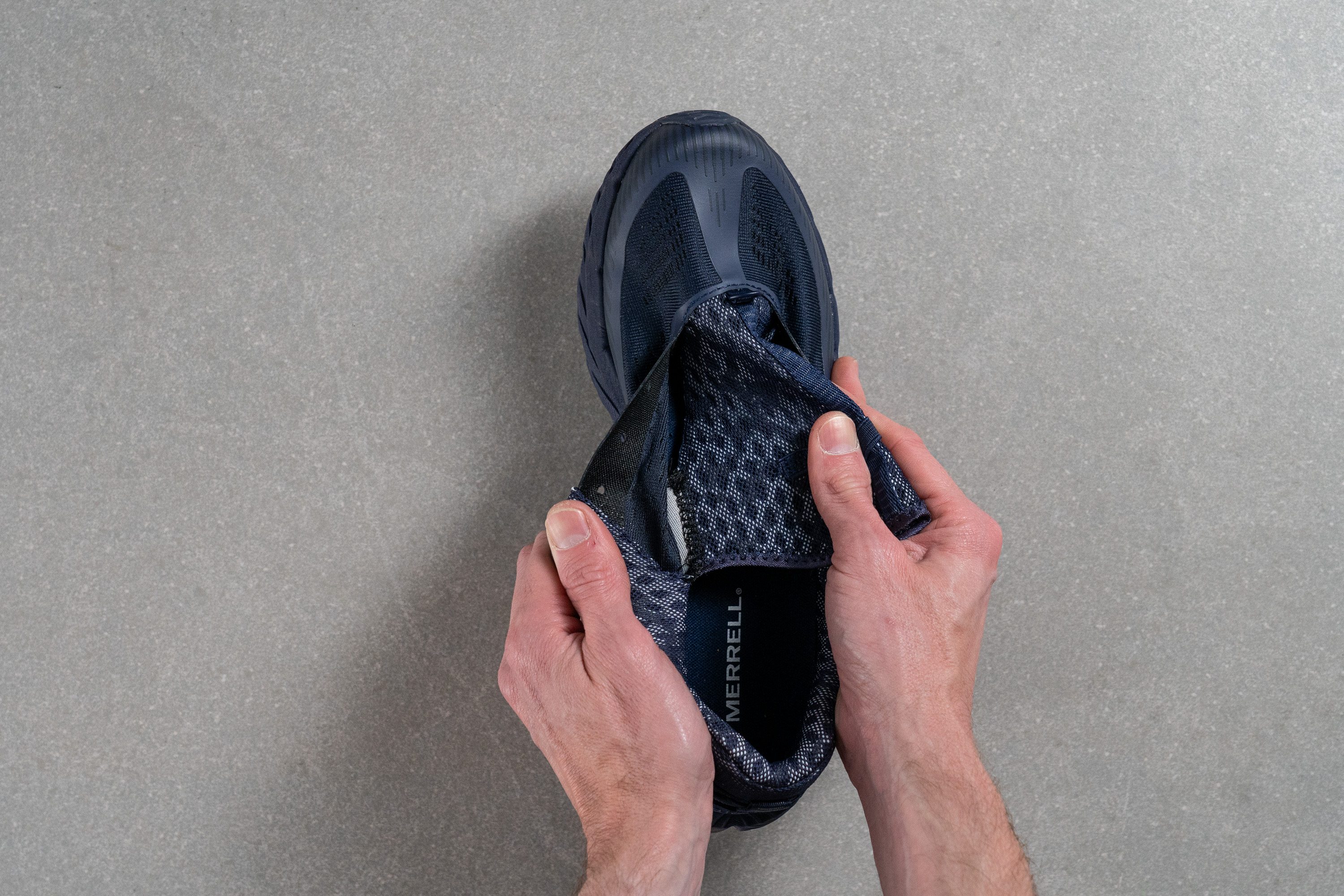
| Agility Peak 5 | Both sides (semi) |
Heel tab
In the heel, there's a pull tab that's too small for our fingers, yet large enough to pull comfortably or hook a D-Ring ankle gaiter for those challenging, mud-caked trails.

| Agility Peak 5 | Pull tab |

